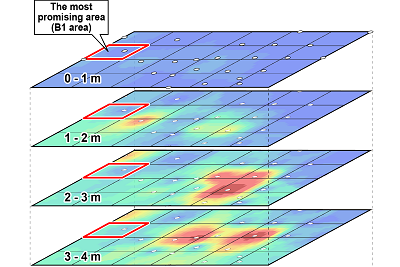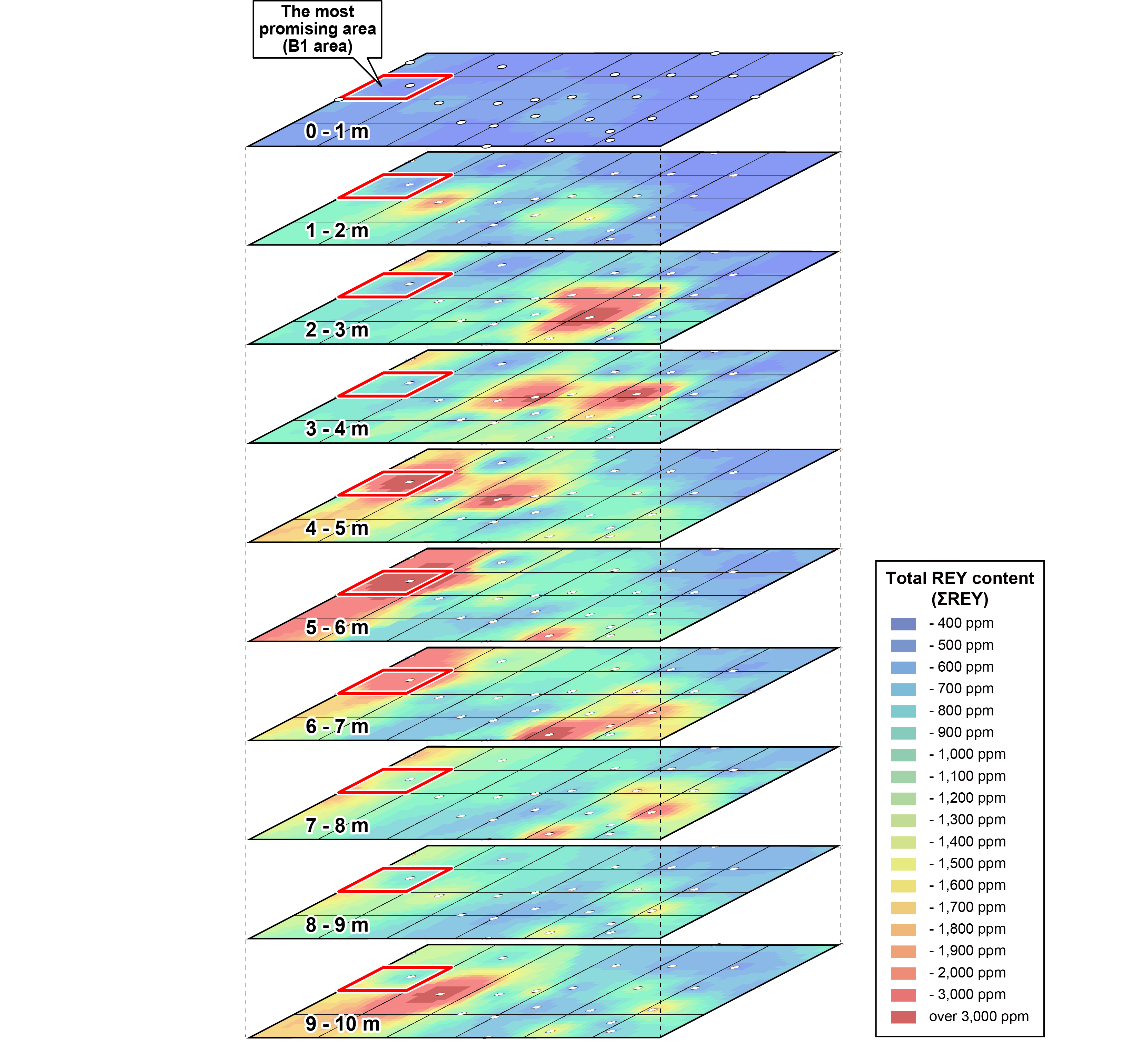Enormous resource of rare-earth elements unearthed in Japan's exclusive economic zone Researchers render visual description of resource distribution, present effective mineral processing procedure


The spatial distribution of average total REY contents of deep-sea mud for every meter below the seafloor. Colors correspond to the REY content: darker red indicates higher REY content, thus holding promise as a resource for the elements. The 105-square-kilometer rectangular section framed in red, referred to as the "B1 area," contains the largest amount of REY in the studied area.
© 2018 Yasuhiro Kato.
Researchers at the University of Tokyo have shown that the amount of rare-earth elements and yttrium (REY)-rich mud in the Japanese exclusive economic zone (EEZ) around Minamitorishima Island accounts for hundreds of years of annual global demand. Moreover, they established a mineral processing procedure that greatly enhances the economic value of the mud.
Often called "industrial vitamins," REY are indispensable for various state-of-the-art technology sectors including renewable energy, electronics, medicine and others. At present, a single producer, China, dominates global production of REY. This bottleneck creates economic and supply risks. Against this background, deep-sea mud highly enriched in REY was found in the Minamitorishima EEZ in 2012. Since the discovery, the future development of the mud has gained significant interest.
The research group of Professor Yasuhiro Kato at the University of Tokyo's Graduate School of Engineering visualized the three-dimensional distribution of REY-rich mud in the southern part of the Minamitorishima EEZ by using ArcGIS software, and successfully evaluated its resource potential. The result demonstrated that the REY resource amount for the research area of 2,500 square kilometers is more than 16 million tons of rare-earth oxides. Moreover, the group focused on a coarse grain size of biogenic calcium phosphate grains, or fish teeth and bone fragments in REY-rich mud, that contains almost all of the REY in REY-rich mud. The researchers conducted experiments of grain-size separation, resulting in increased REY concentration by 2.6 times of the original mud sample. By increasing the concentration in obtainable samples, the scientists can reduce the amount of wastage when retrieving them.
The confirmation of the tremendous resource amount of REY-rich mud within the Minamitorishima EEZ and improved economic value of the mud by the effective mineral processing procedure can make a significant impact on Japan's resource strategy. Through future development of REY-rich mud extraction in the Minamitorishima EEZ, industries utilizing REY are expected to advance significantly not only in Japan but also around the world.
"Our findings will bring seafloor mineral resources, which until now were merely an object of scientific research, to a realistic target of commercial development," says Kato. He continues, "It is very important to accelerate the research efforts to achieve the development of REY-rich mud through the close collaboration between government, industry and academia."
Papers
Yutaro Takaya, Kazutaka Yasukawa, Takehiro Kawasaki, Koichiro Fujinaga, Junichiro Ohta, Yoichi Usui, Kentaro Nakamura, Jun-Ichi Kimura, Qing Chang, Morihisa Hamada, Gjergj Dodbiba, Tatsuo Nozaki, Koichi Iijima, Tomohiro Morisawa, Takuma Kuwahara, Yasuyuki Ishida, Takao Ichimura, Masaki Kitazume, Toyohisa Fujita, Yasuhiro Kato, "The tremendous potential of deep-sea mud as a source of rare-earth elements," Scientific Reports Volume 8 Article number 5763: April 10, 2018, doi:10.1038/s41598-018-23948-5.
Link (Publication )
)
Related links
- Graduate School of Engineering

- Department of Systems Innovation, Graduate School of Engineering

- Kato & Nakamura Laboratory, Department of Systems Innovation, Graduate School of Engineering (Japanese)

- Frontier Research Center for Energy and Resources, Graduate School of Engineering

- Department of Resources and Environmental Engineering, School of Creative Science and Engineering, Waseda University (Japanese)

- Ocean Resources Research Center for Next Generation, Chiba Institute of Technology

- Japan Agency for Marine-Earth Science and Technology (JAMSTEC)






